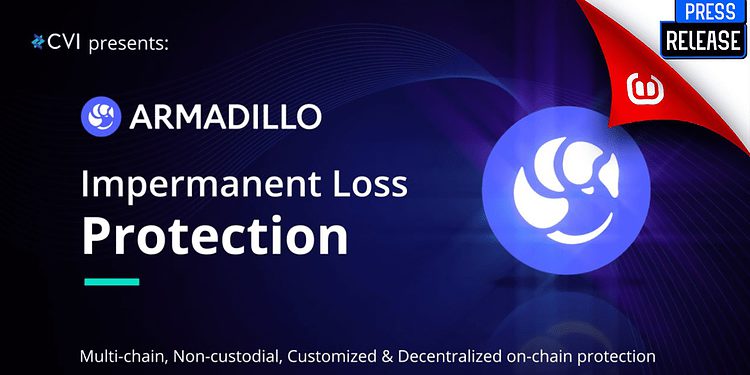PRESS RELEASE
Providing liquidity in a decentralized liquidity pool comes with a lot of assumed risks which include system hacks, protocol vulnerabilities, user manipulation, and a lot more. Another risk that is often overlooked, but can often have a significant impact on profitability, is impermanent loss. In simple terms, an impermanent loss occurs when providing liquidity to a 2-asset liquidity pool, and the price of the deposited assets changes from the time they were deposited.
In a volatile market like today’s, liquidity pool participants are likely to experience impermanent losses when staking or depositing crypto assets within a liquidity pool. Although they significantly impact returns, there are no options for combatting impermanent losses. In 2021, a study by Cornell University found that over 43% of participants in liquidity pools lost money to impermanent loss — in fact, the report found that liquidity pool participants were better off holding their tokens rather than participating in the pools, given the impact of impermanent loss. Most liquidity operators utilize short-term/profit-taking arbitrageurs to get the price of their pool’s asset to the current price — ensuring the pool’s price is balanced internally and externally. However, this has not always proven to be effective, and in some cases, the impermanent losses have increased in magnitude with the introduction of these arbitrageurs.
Two examples of Impermanent loss
- Let’s assume the price of ETH is $1,000 and a trader joins an ETH-USDC liquidity pool by depositing 0.5ETH and 500USDC, for a total market exposure of $1,000. Let’s also assume that the price of ETH appreciates from $1,000 to $2,000, while the stablecoin remains constant (as it should). In this situation, the trader’s total market exposure in the pool should be $1,500 given ETH’s appreciation in price, however, the trader will only receive $1,414.21 due to impermanent loss. So by calculation, the trader lost about 6% to impermanent loss and this is only at minimum — there is a chance that this loss increases as the market fluctuates.
- This also happens when the price of one of the assets in the pair depreciates in value. So using the example above, if the price of ETH dropped from $1,000 to $400 and the stablecoin kept its peg, the trader’s total value in the pool will be worth $632. This will lead to an impermanent loss of about 10%, which can only get worse as the value of ETH falls.
Introducing Armadillo – Impermanent Loss Protection
Using the Black-Scholes option pricing model, the Crypto Volatility Index (CVI) computes the implied volatility of Bitcoin and Ethereum option prices and then analyzes how markets anticipate future volatility. The CVI team has developed a toolbox of decentralized risk management solutions that are applicable and relevant in today’s highly dynamic crypto markets. Armadillo is just one recent addition to this toolbox and looks to be one of the most promising solutions for liquidity providers. Initially, the CVI team had released a beta version of the Armadillo (impermanent loss protection) and this version had a limit on the number of premiums a user could purchase. Now, CVI had launched the “alpha version” Armadillo, with additional features and purchasing flexibility.
With Armadillo, users can do the following:
- purchase a custom policy that matches their relevant pair and amount
- specify the coverage period (i.e. 14 days, 30 days, or 60 days)
During the coverage period, the users will be covered from any impermanent losses that occur on the specific asset and across the specified date ranges. Through this, users will be able to maximize any returns or benefits associated with providing liquidity while protecting themselves from any impermanent losses. The impermanent loss protection is essentially structured as an insurance contract represented in the form of an NFT that signifies coverage value, appropriate time frame, and the applicable token pairs. If/when a user incurs an impermanent loss and it falls within the appropriate criteria (i.e. time period, asset pair, etc), the amount is automatically refunded to their wallet in a seamless and secure manner.
A few points to note
Multi-chain protection: Armadillo is available cross-chain and on any DEX, chain, or liquidity platform. The Armadillo is proud to be the only solution that can offer this. In addition, there is no requirement to stake or provide liquidity on the Armadillo platform — i.e. you can use our impermanent loss solution outside the Armadillo ecosystem with no issues. We offer the first impermanent loss cross-chain solution that is fully decoupled from the liquidity it protects.
Customizable protection: The Armadillo team has given full control to the users on the terms and conditions applicable to their impermanent loss protection. Users can set specific details like the token pairs, asset amount, timeframe, and more.
Decentralized on-chain protection: Smart contracts and oracles are used to prevent manipulation and external attacks. Moreover, as the premium paid for the protection is fully decoupled — there is no counterparty risk for the protected liquidity.
Armadillo will enable liquidity providers to limit their exposure to the volatility of their underlying token deposits in liquidity pools. Given our extensive experience building out risk management solutions like the CVI, ETHVI, volatility tokens, and more — we are at the forefront of solving the impermanent loss problem.






